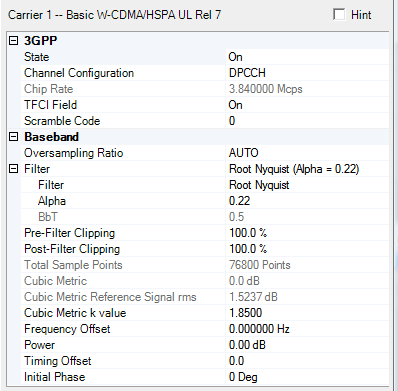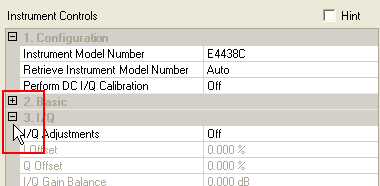User Interface Basics
Viewing Parameter Descriptions
Check  in the upper right corner above the parameter configuration
table, and then click a parameter cell to display a brief description.
The initial state is unchecked.
in the upper right corner above the parameter configuration
table, and then click a parameter cell to display a brief description.
The initial state is unchecked.

Working with Cells
The software interface uses cells (similar to a spread sheet) for configuring various parameters. Some cells have discrete settings where you choose from a selection of parameters; others are arbitrary and allow you to enter a value within a designated range.
If you change a default parameter, the new setting becomes to indicate the setting has changed and is no longer the default value.
Discrete Settings
The parameter uses discrete settings; you must select from either or .
, double-click the cell with the parameter name, or double-click the cell containing the current setting of the parameter. Each double-click changes the parameter to the next available selection. All non-default selections appear in bold text.

You can also change a discrete setting by clicking the down arrow of the cell and then moving the mouse pointer to click the desired selection.

Click the
button 
 to make a discrete setting selection for the
cell when configuring a channel.
to make a discrete setting selection for the
cell when configuring a channel.

Arbitrary Settings
and parametersuse arbitrary settings. You can enter any value within the designed range.

To change an arbitrary setting, double-click either the cell with the name of the parameter or the setting. This highlights the current setting. When the value is highlighted, enter the new value.

You do not need to type "MHz"; the letter "m" is sufficient. The same is true for GHz and kHz.

Using the Tree View
The left pane of the main window is called the  tree view.
It is useful for navigating between the quick setups node, the hardware
setup nodes, and waveform setup nodes. The right pane of the main window
is called the
tree view.
It is useful for navigating between the quick setups node, the hardware
setup nodes, and waveform setup nodes. The right pane of the main window
is called the  parameter view.
This area enables you to select the waveform parameters and instrument
settings. Selecting an item in the tree view enables the related elements
in the parameter view.
parameter view.
This area enables you to select the waveform parameters and instrument
settings. Selecting an item in the tree view enables the related elements
in the parameter view.
Resizing Window Panes and Cell Columns
You can resize window panes and cell columns for better viewing. As
you move the mouse pointer over a border, it changes form, indicating
that the border can be moved  horizontally
or
horizontally
or  vertically.
Hold down the left mouse button and drag the border to its new position.
vertically.
Hold down the left mouse button and drag the border to its new position.
Collapsing and Expanding Tables
To create more viewing space in a window pane, click the  icon to collapse
parameter selection tables you are not using. Parameter selection tables
have function groups indicated by the
icon to collapse
parameter selection tables you are not using. Parameter selection tables
have function groups indicated by the  or
or  icons.
icons.





